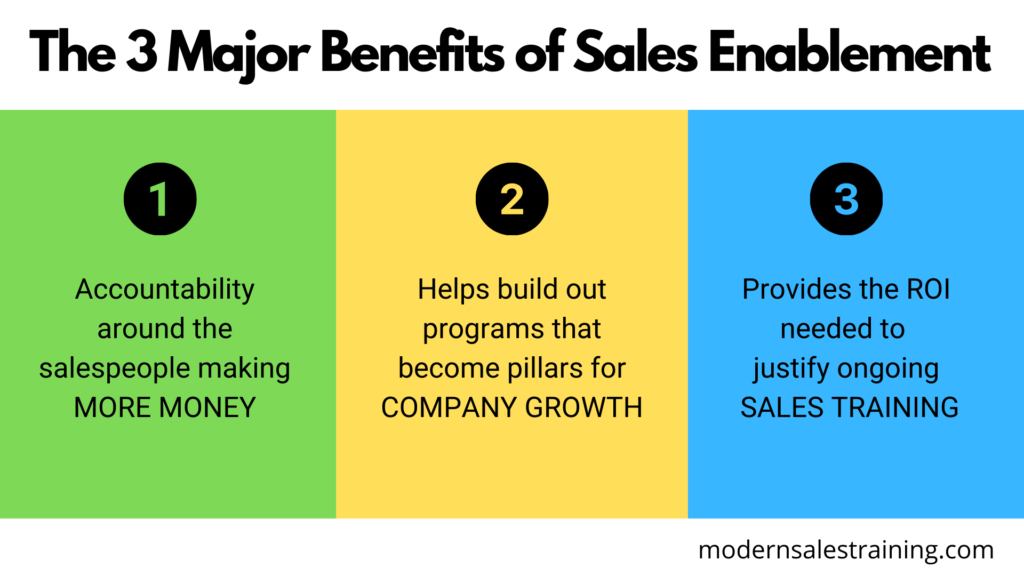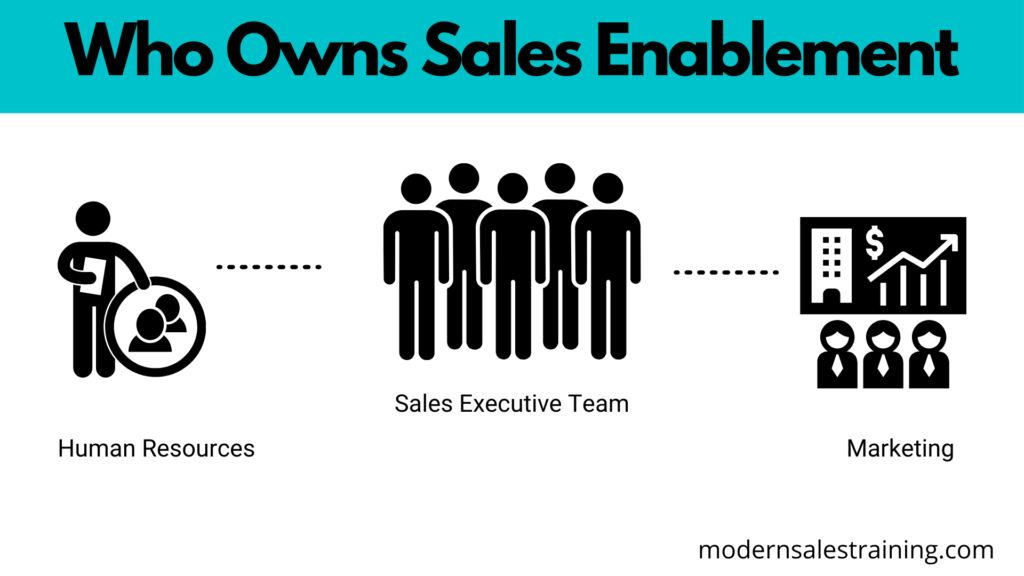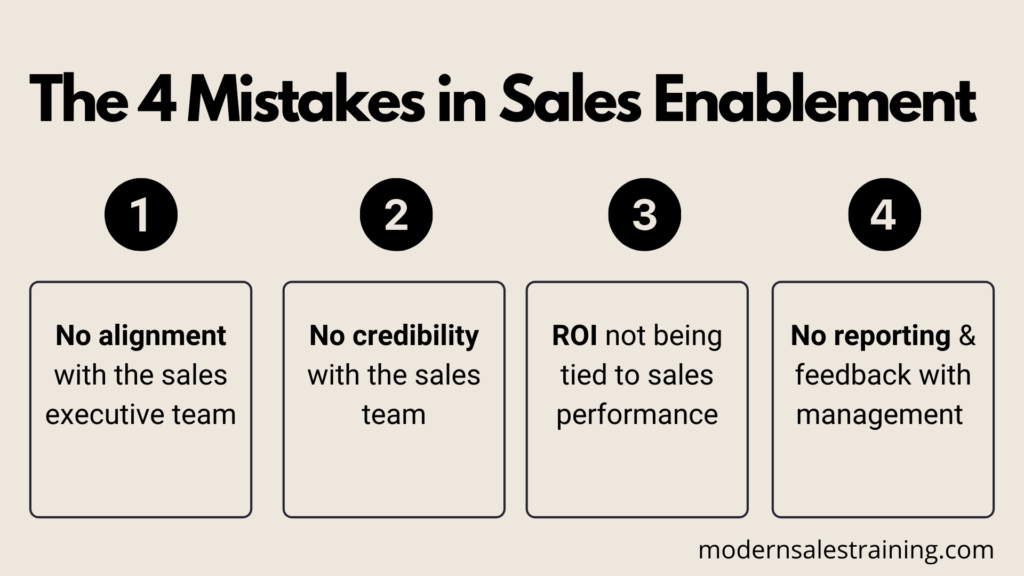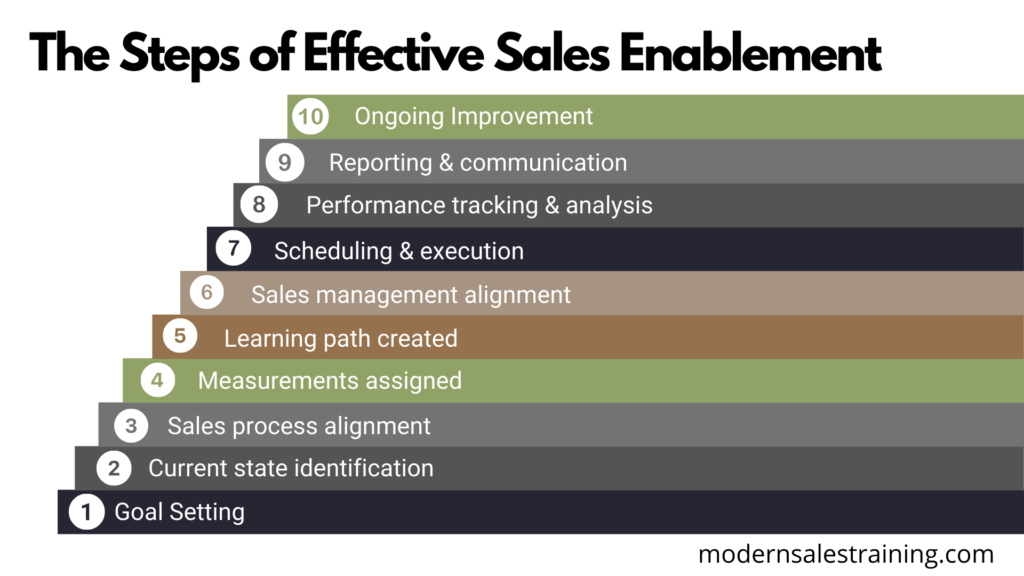
Why Sales Training is Your Key to Exponential Growth
Sales training is the process of developing a salesperson’s skill sets from one measurable level to the next with the goal to improve sales performance.

Top sales performers aren’t created after attending one sales training event.
They didn’t take one sales course or were certified in one sales certification. Like any successful person in life, they spent the time, effort, and discipline to learn and master the skills for sales success.
Your path to creating top sales performers in your organization wont come from sales training alone. It will, however, come from sales enablement.
In this article, we will cover how to set up an elite sales enablement strategy. We will focus in on these topics:
Elite businesses have sales enablement programs in place that challenge their sales teams to continuously grow and improve sales performance. Understanding how to best leverage a sales enablement strategy in your business can make a tremendous difference in the success of your organization.

Sales enablement is the continuous process of providing sales teams with the skills, resources, and coaching they need to improve their performance. It’s not a one-size-fits-all strategy and is tailored to the individual needs of the salesperson, sales team, and evolving goals of the organization.
See related: Sales Training: Your learning path to sales success

Sales enablement includes the strategy before, during and after any sales training occurs in an organization. It adds the accountability factor to ensure the training sticks and the salespeople who attend are actually getting better in skill and performance.

Salespeople care about making money. A lot of money. Why else would they put up with the stresses of prospecting, rejection and updating their CRM? They want to learn how to sell and then get out there and earn a great living.
The way organizations help their salespeople do this is by providing them with sales training and a compensation plan that motivates them to conquer fear on a daily basis. However, businesses without sales enablement leave their salespeople to figure it out alone after a sales training event. The result is whatever the salesperson learned, will most likely be gone after a few days.
That’s where sales enablement comes in. Sales enablement puts a strategy in place to ensure there are processes to help the salesperson improve upon their new skills which ultimately help them make more money.
Sales enablement oversees the creation of new programs inside of an organization that are designed to level up the sales force. These programs, or learning paths, help accelerate the goals of the organization and make it easier to execute on the proven sales process.
The learning paths also become natural career paths for the sales organization. This creates a natural progression for the employees to stay at the company for the long-term which benefits both the salesperson and the company as their skills improve over time and so do their results.
One of the most challenging pieces of sales training to an organization is in measuring the effect it has on the bottom line. The logic exists that the better a salesperson becomes, the more sales they will close. However, how can you tie performance to a specific sales training?
Often organizations view sales training more as an investment in their salespeople and a motivation factor to build a stronger connection with their employees.
Sales enablement is the missing link to proving ROI with sales training. With a sales enablement strategy, it’s possible to connect a sales training with metrics on the backend to measure performance. This type of tracking is done by sales enablement and, once the ROI is actualized, the amount of sales training and programs increase. This in turn rapidly grows the organization.

Sales enablement ownership varies depending on the organization. However, it should be overseen by the executive sales management with a dotted line to marketing and human resources. All sales enablement programs must be aligned with the current go to market strategy and the sales process. Human resources needs to be involved as they have a pulse on all sales employees and marketing needs to be involved as they need to align new initiatives with other parts of the sales process.
Without sales enablement being overseen by the ones running the sales organization, you could run into challenges of relevance and adoption of the strategies being implemented.

Having a sales enablement strategy isn’t full proof. There are common mistakes made by business every day that get in the way of sales success.

The strategies that sales enablement has to execute on are not always looked upon favorably across the organization. In some cases they can be seen as ruthless enforcers of the sales process.
A big part of the role of sales enablement is to track progress amongst the sales organization. This tracking might not be seen as a positive by individuals or sales managers that are struggling. That’s why it’s important to have the sales executive team support the sales enablement teams efforts and help shape the messaging around their actions.
Without the support from senior management, sales enablement is guaranteed to fail and be short lived.
Since sales enablement is on the front lines helping the sales team improve in their sales skills, it’s normal to question their credibility. That’s why it’s recommended to have the roles of sales enablement to extend into sales coaching and leading by example in prospecting and in customer facing opportunities.
The material being taught by sales enablement needs to be constantly inspected. Is the content working in application? If not, then it needs to be further tailored to the organizational needs. Adjusting the messaging and content based upon the sales enablement teams actions in the field demonstrate credibility that the salespeople are learning from a team that has proven experience.
However, many organizations don’t have sales enablement ROI tied to sales performance, which is a reason why they ultimately fail to gain any credibility with the sales force.
Sales enablement, like all roles in an organization, has a certain job function. At the end of the day, sales enablement activity should result in salespeople getting better at their jobs. That means more revenue and more profit to the bottom line.
It’s not enough to have happy employees. If that was the goal, the organization could just bring in people to give massages to their employees or provide them with more sales contests and higher commission rates in their compensation plan.
This is another area businesses fail in implementing a sales enablement strategy. Without clearly defined goals for the sales enablement team, the whole thing can fall apart fast.
Communication is critical when it comes to sales enablement. They are responsible for the tracking, analysis and reporting of the data to the sales, marketing and human resources teams. Without communication and feedback mechanisms in place, processes can’t be adjusted and coaching can’t be administered where it is most needed.
The sales executive team needs to understand how the strategies are working by region, by team, and by individual salesperson. Are they effective? How could they be improved? Where do they need to add more support?
The marketing team needs to see the sales efforts in regards to certain strategies, tools and promotions. Are their efforts helping them? How could they help them be more aligned?
The human resources department needs to understand the individual performance of the salespeople in the company. Are there certain sales managers that need more assistance with their sales teams? Are there conflicts going on that need immediate attention? How can they better align with the sales executive team to provide the right documentation to coach in or out salespeople that are underperforming?

Putting together an effective sales enablement strategy requires many moving parts. By design, there must be alignment with the sales management team as their job is to execute upon their vision.

Goal setting is where any sales enablement strategy starts. There must be a vision or an objective for the sales training or sales strategy the organization is looking to achieve.
Some of the questions you could ask yourself here are:
You need clarity around the vision before you start figuring out how to get there.
After choosing a goal or strategy for the organization, you now need to determine with the current state of the business looks like today. Ultimately you need to assign data to where you are at. Without data from the business today, you won’t be able to measure if you are making progress.
Sometimes it’s in this step that you realize you don’t have a good way to choose the current state. Perhaps you have not been tracking that data. It’s important to do you best to assign metrics on your best estimate if that is the case.
From here we need to determine where in the sales process this sales strategy exists. Any time you create a sales enablement program you need to consider that you will be rolling it out in two waves. The first wave will be with the entire sales organization to educate them on the new initiative. The second wave will be how can you train the new employees that start after the first wave. That’s why you need to determine where it fits inside of the current sales process. Once you understand where it fits, you can make the adjustments inside of your sales new hire training program.
The next step is to determine how you will measure the effectiveness of the program. Looking at the current state metrics from step 2, identify the skill sets and performance metrics that are associated with the program and what expected increases they should have after they complete the program. Then you need to set up a process of collecting that data and tracking it after the fact.
Now that you have your goals and the metrics, you need to develop the program that helps improve the skills and performance metrics in those particular areas. How can you blend the learning with online courses, in person instruction and in field assessments. How much time will it take the sales enablement team to provide the sales training? What is the commitment for the salesperson outside of their normal activities? How is the sales enablement team proving that the strategy and their ability to teach it is credible. How can the program be evergreen and the process utilized within the sales new hire onboarding process?
In order for there to be company wide adoption, the sales managers need to be included inside of the training program. This is done by over communicating the program as it’s being built and helping them be part of the creation process so they all can reinforce the messages as time goes on. Then there needs to be an abbreviated training for the sales management team themselves so they can become ambassadors for the program.
From here the sales enablement team needs to own the scheduling of the new program. That scheduling needs to be over communicated throughout the organization and the salespeople need the time to prepare around their schedules for the upcoming training. The sales enablement team needs to complete the program by design with measuring all the data needed to show a proper before and after once the program is completed. Often this is done with a certification.
Sales enablement is in charge of the tracking and analysis of the data of each of the sales employees that have gone through the program. Did they improve? Was it a success? Do some salespeople need to go back through it again? What do they need to do to enhance the program itself? How could they improve their own presentation? Is there a follow up survey you could ask those who attended? This data needs to be analyzed and documented by sales rep, sales team, and sales region.
With the data collected, it’s the responsibility of sales enablement to get that data and analysis back into the hands of the sales executive team and other departments like human resources and marketing to gain feedback on how to improve it going forward. They do this by over communicating to them verbally and in a written format.
After the feedback is gathered in step 9, the sales enablement team then enhances the program and updates the learning path in step 5 and communicates the updates to the sales management team in step 6 for increased alignment. The program continues to be modified and tested to see if there are better ways to improve it in the future.

As a management team, it’s important to measure the effectiveness of the sales enablement team as they work to achieve the goals of the organization. There are two main divisions of the sales organization that they impact: new hires and tenured salespeople.
The new sales employees that join the team need a lot of attention. They need to learn all about the company culture, the products and services they offer, the tools they use for the job and even how to sell. This new hire training can be very extensive and be a blend of both classroom and in field sales training.
There are many different metrics that a company could use to measure the effectiveness of the sales enablement team in regards to onboarding new hire salespeople, however, nothing is more effective than inspecting new hire revenue, new hire deal quantity and pipeline. These three areas are the results of a successful training. The better the sales enablement team does here, the more new hires will be on the path to proficiency in prospecting, qualifying, building value and closing deals with a healthy pipeline.
Learning doesn’t end with new hires. That’s why sales enablement is also on the hook for helping develop the rest of the sales force. This strategy has a wider net as it has to take into account skill set proficiencies, performance and skill gaps and certifications.
As the year goes on it’s normal for sales managers to spend more time with performing salespeople as they are on the hook for the team hitting sales quota for the month. Unfortunately, that causes them to help the other members on their team much less. That’s why sales rep participation and pipeline is an important metric to track for sales enablement as it could help them work with the sales manager to provide micro trainings to help out the rest of the team in the areas that make the most sense for their continued development.
It’s also common for organizations to quickly develop an at risk program that helps provide more attention to the struggling salespeople that have been underperforming for consecutive quarters and are outside of the new hire bubble.

There are many different types of sales enablement programs that could be going on inside of an organization. They each have their own unique way of leveling up sales skills.
New hire sales training is part of sales onboarding and should cover company culture, the products and services they offer, the tools they use for the job and, most importantly, sales fundamentals. This new hire training can be very extensive and be a blend of both classroom and in field sales training. Because this is the entry part of an organization, this tends to be the first program created.
When you first start tracking the salespeople across the organization, it’s easy to see which ones are underperforming. You could call those salespeople as reps that are “at risk” of leaving or needing additional development in order to get back on track. An “at risk program” is designed to help those salespeople that might only need a little extra attention. The material in the sales training here is usually around prospecting as it could help them fill more of their sales funnel and bring them more deals to close in the months ahead.
Sales managers are the lead sales enablement professional for their sales teams. That’s why there are sales enablement programs around weekly micro trainings that are done weekly with their sales teams. The topics are decided upon in advance by the sales manager and the sales enablement team to be specifically focused on topics that are most relevant to the challenges the team is facing. These types of engagements are typically executed by the sales manager themselves.
In any sales organization there are different layers inside the sales force whose responsibilities stray a bit from the regular sales development path. In these situations, businesses create a separate sales learning path for that specialist role. Depending on the size of the organization, the sales manager for that role is often the one who takes the lead on developing the employees that go down this sales path. However, sales enablement takes a part inside of the program.
Another program that comes from sales enablement is a mentoring program. Usually sales mentors are created out of a necessity due to lack of sales managers. The goal of this program is to provide extra support to those tenured salespeople who are looking to rapidly grow their skill sets. Mentor programs are normally connected with a leadership development program to build up coaching and tracking skills.
Customer service is a sales enablement program that is often a company-wide initiative. All of the employees could be part of this training to help improve their skills around better serving their customer and handling difficult situations. This also ends up being a culture enhancing program and team unity opportunity.
Top performing salespeople are another target of sales enablement programs. This program is typically centered around winning larger opportunities, learning strategies to win with increased profit and best practice sharing amongst the higher performers. Sales enablement offers the structure of the program and allows the top performers themselves to dictate the topics, instruction methods and frequency of the meetings.
Many businesses have to hire talent outside of their organization to fill management roles. That’s because they lack an internal program designed to prepare high potentials on the ways to be successful managing people at their company. Leadership development is a sales enablement program that develops leaders on sales teams and future sales management in the company.
Sales management training is the most important training program that is commonly neglected. Without a leadership development program, high performing salespeople are put into a managerial position and left to figure it out on their own. Sales management training needs to include recruiting and selection, human resources and personnel management, performance management, time management and sales coaching. Those are all skills that are not taught inside of the sales process.
The executive team at the top has a different skill set they need to become proficient in. They need to understand how to create a winning culture, public speaking and influence, financial metrics of the organization and situational leadership. Sales enablement often facilitates the outsourcing of this level of training for their people.

Now that you have an understanding of sales enablement and how it could help you create a world-class sales organization, it’s time to take the next steps to start building out your own learning paths.
Here are some questions to help you start along your path:
Just imagine how successful your organization will be once you have a strong sales enablement program. Let us know if we can help!

Sales training is the process of developing a salesperson’s skill sets from one measurable level to the next with the goal to improve sales performance.

A sales process is a set of repeatable steps that a sales organization does to find the right buyer, get them interested in their product or service and close them in a predictable timeframe.

“It always comes down to price…”
In the first bonus sales training episode of the In Between Sales Calls Podcast, Jason Scoggins shares a practical tip on how you can go the extra mile in sales and improve your results in your sales career.